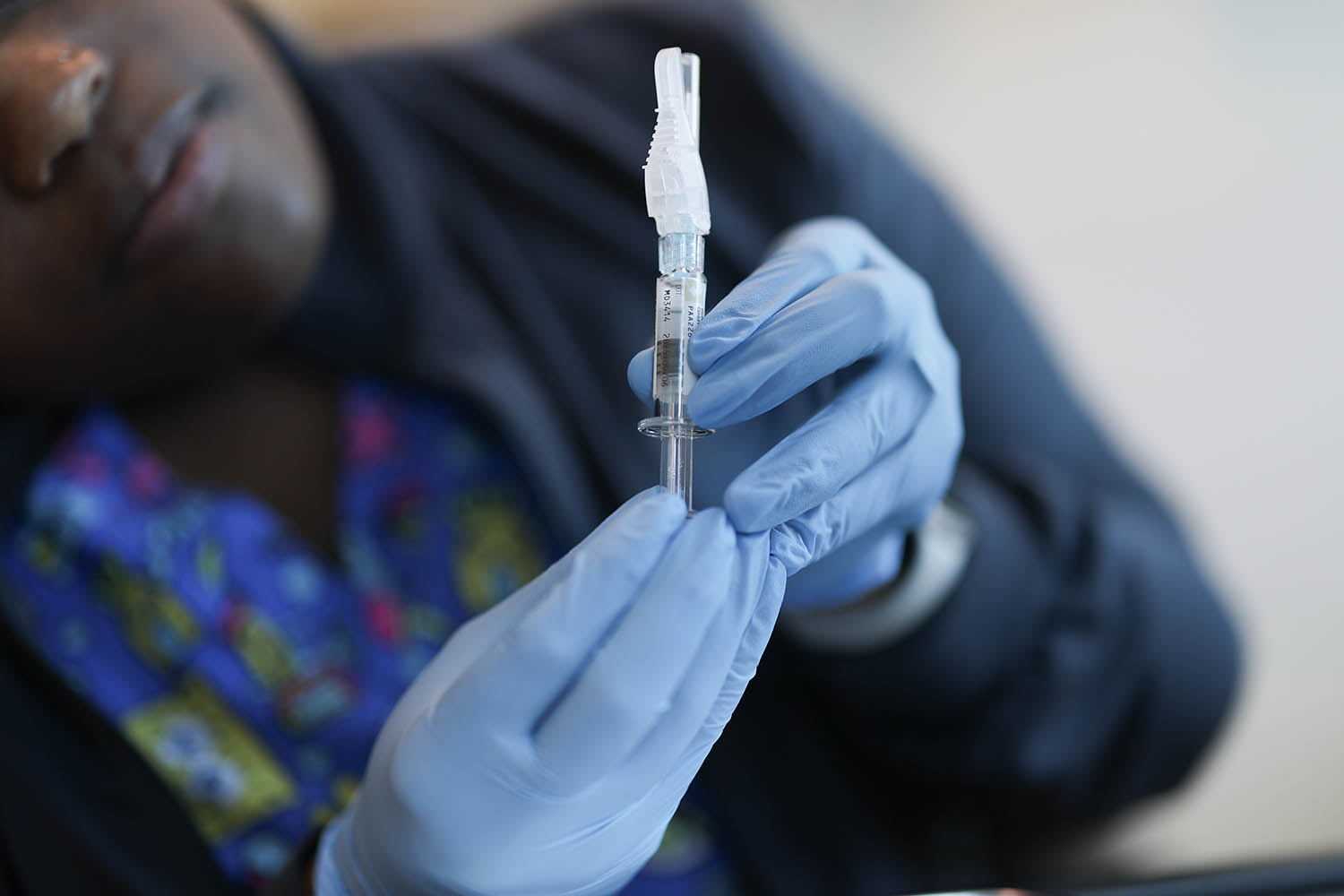Thought of the Day

One cannot refuse to eat just because there is a chance of being choked, so don’t let fear stop you from living your life.


One cannot refuse to eat just because there is a chance of being choked, so don’t let fear stop you from living your life.

CHARLOTTE, N.C. (AP) — A federal grand jury indicted a man on a charge he fatally stabbed a Ukrainian refugee on a Charlotte, North Carolina, commuter train
Wednesday’s indictment on a charge of causing death on a mass transportation system keeps a possible death sentence on the table for Decarlos Brown Jr. if prosecutors decide to seek it.
Brown stabbed 23-year-old Iryna Zarutska in an apparently random attack captured on video. Brown is also charged with the killing in state court, but federal prosecutors stepped in after growing questions about why Brown was on the street despite 14 prior criminal arrests.
President Trump’s administration has used the case to show how it thinks local leaders, judges and policies in Democratic-led cities like Charlotte are failing to protect their residents from violent crime.
Video from the commuter train showed Zarutska entering a light-rail train on Aug. 22 and taking a seat in front of Brown, who was seated behind her. Minutes later, without any apparent interaction, he pulled out a pocket knife, stood up and slashed her in the neck, investigators said. Passengers screamed and scattered as she collapsed.
Zarutska had been living in a bomb shelter in Ukraine before coming to to the U.S. to escape the war, according to relatives, who described her as determined to build a safer life.
The indictment indicates the charge against Brown is eligible for the federal death penalty.
Brown had cycled through the criminal justice system for more than a decade including serving five years for robbery with a dangerous weapon in Mecklenburg County, according to court records. He was arrested earlier this year after repeatedly calling 911 from a hospital, claiming people were trying to control him. A judge released him without bail. His mother told local television she sought an involuntary psychiatric commitment this year after he became violent at home. Doctors diagnosed him with schizophrenia.
The federal case will run parallel with the state case charging Brown with first-degree murder.
The death penalty is also a potential punishment for people convicted of first-degree murder in North Carolina. However, the state has not carried out an execution since 2006. Legal challenges over the use of lethal injection drugs have in part delayed action.
North Carolina’s legislature passed a package of criminal justice bills last month in response to the killing that limits bail and seeks to ensure more defendants undergo mental health evaluations.
It also could restart the state death penalty by calling for the state Adult Correction Department secretary to find another form of execution if lethal injection is not available.

It’s soup season and this one is a classic–creamy, cheesy and perfect for a fall day. This recipe also reheats super well so you can keep enjoying these fall flavors and lessen your meal-prep stress.
1. Sauté aromatics
In a large pot, melt butter over medium heat. Add onion and cook 3–4 minutes until translucent. Stir in garlic and cook for 30 seconds until fragrant.
2. Make the roux
Sprinkle in flour, stirring constantly for about 1 minute to form a paste. Slowly whisk in broth until smooth and thickened.
3. Add milk and vegetables
Pour in milk, then add broccoli and carrots. Simmer over medium-low heat for 15–20 minutes, stirring occasionally, until broccoli is tender.
4. Add cheese
Reduce heat to low and gradually stir in cheddar cheese until melted and creamy.
5. Season it up
Add salt, pepper, and a pinch of nutmeg or cayenne if desired. Taste and adjust seasoning before serving.
6. Serve and enjoy
Serve warm and enjoy this creamy and delicious taste of fall.
*For a smoother texture, use an immersion blender to partially blend the soup, leaving some chunks for texture.


Giving your son a skill is better than giving him 1,000 pieces of gold.

By LAURAN NEERGAARD AP Medical Writer
WASHINGTON (AP) — The most widely used COVID-19 vaccines may offer a surprise benefit for some cancer patients – revving up their immune systems to help fight tumors.
People with advanced lung or skin cancer who were taking certain immunotherapy drugs lived substantially longer if they also got a Pfizer or Moderna shot within 100 days of starting treatment, according to preliminary research being reported Wednesday in the journal Nature.
And it had nothing to do with virus infections.
Instead, the molecule that powers those specific vaccines, mRNA, appears to help the immune system respond better to the cutting-edge cancer treatment, concluded researchers from MD Anderson Cancer Center in Houston and the University of Florida.
The vaccine “acts like a siren to activate immune cells throughout the body,” said lead researcher Dr. Adam Grippin of MD Anderson. “We’re sensitizing immune-resistant tumors to immune therapy.”
Health Secretary Robert F. Kennedy Jr. has raised skepticism about mRNA vaccines, cutting $500 million in funding for some uses of the technology.
But this research team found its results so promising that it is preparing a more rigorous study to see if mRNA coronavirus vaccines should be paired with cancer drugs called checkpoint inhibitors — an interim step while it designs new mRNA vaccines for use in cancer.
A healthy immune system often kills cancer cells before they become a threat. But some tumors evolve to hide from immune attack. Checkpoint inhibitors remove that cloak. It’s a powerful treatment – when it works. Some people’s immune cells still don’t recognize the tumor.
Messenger RNA, or mRNA, is naturally found in every cell and it contains genetic instructions for our bodies to make proteins. While best known as the Nobel Prize-winning technology behind COVID-19 vaccines, scientists have long been trying to create personalized mRNA “treatment vaccines” that train immune cells to spot unique features of a patient’s tumor.
The new research offers “a very good clue” that maybe an off-the-shelf approach could work, said Dr. Jeff Coller, an mRNA specialist at Johns Hopkins University who wasn’t involved with the work. “What it shows is that mRNA medicines are continuing to surprise us in how beneficial they can be to human health.”
Grippin and his Florida colleagues had been developing personalized mRNA cancer vaccines when they realized that even one created without a specific target appeared to spur similar immune activity against cancer.
Grippin wondered if the already widely available mRNA coronavirus shots might also have some effect, too.
So the team analyzed records of nearly 1,000 advanced cancer patients undergoing checkpoint inhibitor treatment at MD Anderson – comparing those who happened to get a Pfizer or Moderna shot with those who didn’t.
Vaccinated lung cancer patients were nearly twice as likely to be alive three years after beginning cancer treatment as the unvaccinated patients. Among melanoma patients, median survival was significantly longer for vaccinated patients – but exactly how much isn’t clear, as some of that group were still alive when the data was analyzed.
Non-mRNA vaccines such as flu shots didn’t make a difference, he said.
—-
The Associated Press Health and Science Department receives support from the Howard Hughes Medical Institute’s Department of Science Education and the Robert Wood Johnson Foundation. The AP is solely responsible for all content.

By STEVE REED AP Sports Writer
CHARLOTTE, N.C. (AP) — Carolina Panthers quarterback Bryce Young did not practice on Wednesday due to an ankle injury as the team amped up preparation for Sunday’s game against the Buffalo Bills.
If Young can’t play Sunday, veteran Andy Dalton would get the start at quarterback
Coach Dave Canales said he wasn’t prepared to name a starter, calling Young “day to day.”
“He did more than he did yesterday, so that’s good,” Canales said of Young. “That’s our plan right now is each day try to push him a little bit more, see if we can get him out there in a different capacity. He wasn’t able to practice today, but was working on the side, was able to do some movement stuff. We’ll just take it day to day and make the best decision.”
Young, who suffered a right ankle sprain in the second half of Carolina’s 13-6 win over the New York Jets on Sunday, walked into practice without a noticeable limp and carrying his helmet.
However, he headed straight to the stationary bike while teammates began their stretching routine. As the Panthers went into practice mode, Young remained on the side working with trainers doing resistance training and light jogging.
Young has won three straight starts for the first time in his NFL career, but had to leave in the second half against the Jets after injuring his ankle while trying to escape pressure. He was replaced by Dalton and did not return to the game.
Young was seen in a walking boot after the game.
The Panthers signed Matt White to the practice squad Tuesday as a potential backup to Dalton in case Young is ruled out. Hendon Hooker is also on the team’s practice squad and could also be the No. 2 quarterback.
Dalton is 1-5 as a starter in his past three seasons with the Panthers, with 10 touchdown passes and six interceptions.

By THOMAS ADAMSON Associated Press
PARIS (AP) — The Louvre reopened on Wednesday to long lines beneath its landmark Paris glass pyramid, just three days after one of the highest-profile museum thefts of the century stunned the world with its audacity and scale.
The thieves slipped in and out, making off with eight pieces from France’s Crown Jewels at the world’s most-visited museum — a cultural wound that some compared to the burning of Notre-Dame cathedral in 2019.
The Sunday raid — steps from the Mona Lisa and valued at over $100 million — has put embattled President Emmanuel Macron, Louvre chief Laurence des Cars and others under fresh scrutiny. It comes just months after employees went on strike, warning of chronic understaffing and underresourced protections, with too few eyes on too many rooms.
Crowds bunched at the barriers as they were being removed Wednesday, a coda to frantic forensic work and staff briefings that had taken place. Inside, the scene of the crime — the Apollo Gallery housing the Crown Diamonds — stayed sealed, a folding screen obscuring the doorway at the gallery’s rotunda entrance.
Three days on, the jewels remain missing and the thieves are still at large — and reactions are divided.
“For a place like the Louvre, it’s unfathomable,” said Amanda Lee, 36, an art teacher from Chicago. “I heard it took under four minutes. How is that possible here, with no police in sight?”
Others were unperturbed.
“We told the kids it’s a history lesson. The Apollo Room is shut, but we saw the masterpieces,” said Claire Martin, 41, a French lawyer from Versailles visiting with her two children during a school holiday.
“We came for the art,” she said. “The police can deal with the thieves.”
Authorities say the thieves spent less than four minutes inside the Louvre on Sunday morning: a freight lift was wheeled to the Seine-facing façade, a window was forced open and two vitrines were smashed.
Then came the getaway on motorbikes through central Paris. Alarms had gone off, drawing agents to the gallery and forcing the intruders to bolt.
“We have failed,” Justice Minister Gérald Darmanin said, noting that the ability to plant a freight lift undetected on a public way projects “a very negative image of France.”
As it reopened, the Louvre declined questions from The Associated Press to detail any reinforced protocols. It said no uniformed police were posted in the corridors. With school holidays swelling demand, the day was fully booked and access limited.
“I didn’t notice extra security — guards as always, and no police inside. It felt like a normal day,” said Tomás Álvarez, 29, a software engineer from Madrid.
Wednesday’s opening followed a routine closure on Tuesday, a day when the museum is normally shut.
The thieves made away with a total of eight objects, including a sapphire diadem, necklace and single earring from a set linked to 19th-century queens Marie-Amélie and Hortense.
They also made off with an emerald necklace and earrings tied to Empress Marie-Louise, Napoleon Bonaparte’s second wife, as well as a reliquary brooch. Empress Eugénie’s diamond diadem and her large corsage-bow brooch — an imperial ensemble of rare craftsmanship — were also part of the loot.
One piece — Eugénie’s emerald-set imperial crown, with more than 1,300 diamonds — was later found outside the museum, damaged but recoverable.
Prosecutor Laure Beccuau valued the haul at about €88 million ($102 million), a “spectacular” figure that still fails to capture the works’ historical weight. She warned the thieves would be unlikely to realize anything close to that sum if they pry out stones or melt the metals — a fate curators fear would pulverize centuries of meaning into anonymous gems for the black market.
Beccuau said expert analyses are underway; four people have been identified as present at the scene, and roughly 100 investigators are mapping the crew and any accomplices.
The heist has intensified scrutiny of the Louvre’s security. Museum director Laurence des Cars appeared before the Senate’s culture committee Wednesday but top officials have, for now, refused to remove her.
Those include Culture Minister Rachida Dati, who also drew fire Tuesday after telling lawmakers there had been no security failings.
All this comes after Macron announced new measures in January for the Louvre — complete with a new command post and expanded camera grid that the culture ministry says is being rolled out.
It also raises hard questions, including whether Sunday’s breach is tied to staffing levels, and how uniformly the upgrades in the overhaul are being applied.
“It’s a scandal of planning,” said Luca Romano, 52, a civil engineer from Milan visiting Paris with his wife. “If you can plant a freight lift at a palace and no one stops you, that’s a system failure.”
Protection for headline works is airtight — the Mona Lisa is behind bulletproof glass in a climate-controlled case — yet the break-in exposed seams elsewhere in a 33,000-object labyrinth. For many French, the contrast is a public embarrassment at the landmark.
It touches a raw nerve: the issue of swelling crowds and overstretched staff.
In June, a staff walkout over overcrowding and chronic understaffing delayed opening. Unions argue that mass tourism leaves too few eyes on too many rooms and creates pressure points where construction zones, freight access and visitor flows intersect.
On Wednesday, the Louvre’s other star attractions — from the Venus de Milo to the Winged Victory of Samothrace — were open again. But the cordoned-off vitrines in the Apollo Room, guarded and empty, told a different story: one of a breach measured not just in minutes and euros, but in the fragility of a nation’s patrimony.

This simple spiced pecan recipe adds the perfect sweet and crunchy fall touch to a salad or charcuterie–or the perfect snack.
1. Preheat the oven
Preheat the oven to 300°F and line a baking sheet with parchment paper or foil.
2. Prepare the coating
In a large bowl, whisk together the egg white and water until frothy.
3. Toss pecans
Add the pecans to the bowl and toss to coat them evenly in the mixture.
4. Spice them up
In a separate small bowl, mix brown sugar, cinnamon, nutmeg, and salt. Sprinkle this mixture over the pecans and stir until every piece is evenly coated.
5. Bake
Spread the coated pecans in a single layer on the baking sheet, then bake for 35–40 minutes, stirring once halfway through to prevent clumping and ensure even toasting.
6. Cool and enjoy
Remove from the oven and let the pecans cool completely to ensure the coating crisps up. Enjoy as a snack, a spiced crunch on a salad, a crumble topping, and more!


Learning is a weightless treasure you can always carry easily.

By MAKIYA SEMINERA and GARY D. ROBERTSON Associated Press
RALEIGH, N.C. (AP) — Democrats rallying Tuesday against a new U.S. House map proposed by North Carolina Republicans seeking another GOP seat at President Donald Trump’s behest acknowledged they’ll likely be unable to halt the redraw for now. But they vowed to defeat the plan in the long run.
The new map offered by Republican legislative leaders seeks to stop the reelection of Democratic Rep. Don Davis, one of North Carolina’s three Black representatives, by redrawing two of the state’s 14 congressional districts. Statewide election data suggests the proposal would result in Republicans winning 11 of those seats, up from the current 10.
The proposal attempts to satisfy Trump’s call for states led by Republicans to conduct mid-decade redistricting to gain more seats and retain his party’s grip on Congress in the 2026 midterm elections. Democrats need to gain just three more seats to seize control of the House, and the president’s party historically has lost seats in midterm elections.
With Republicans in the majority in both General Assembly chambers and state law preventing Democratic Gov. Josh Stein from using his veto stamp against a redistricting plan, the GOP-drawn map appeared headed to enactment after final House votes as soon as Wednesday. The state Senate gave its final approval early Tuesday on a party-line vote. A House redistricting committee debated the plan later Tuesday.
Still, about 300 protesters, Democratic Party officials and lawmakers gathering outside the old state Capitol pledged repeatedly Tuesday that redrawing the congressional map would have negative consequences for the GOP at the ballot box in 2026 and beyond. Litigation to challenge the enactment on the map also is likely on allegations of unlawful racial gerrymandering.
“We know we may not have the ability to stop the Republicans in Raleigh right now … but we are here to show that people across this state and across this nation are watching them,” North Carolina Democratic Party chair Anderson Clayton said to cheers.
The gathering served Democrats to censure state Republicans they accuse of agreeing to kneel to Trump through a corrupt redrawing of district lines to target Davis.
State GOP leaders defended their action, saying Trump has won the state’s electoral votes all three times that he’s run for president — albeit narrowly — and thus merits more potential support in Congress.
The national redistricting battle began over the summer when Trump urged Republican-led Texas to reshape its U.S. House districts. After Texas lawmakers acted, California Democrats reciprocated by passing their own plan, which still needs voter approval in November.
Republicans argue that other Democratic-leaning states had already given themselves a disproportionate number of seats well before this national redistricting fight started.
“It is incumbent upon us to react to this environment, to respond to this environment, and not let these tactics that have happened in blue states dominate the control of Congress,” state Sen. Ralph Hise, the map’s chief author, said during Tuesday’s Senate debate.